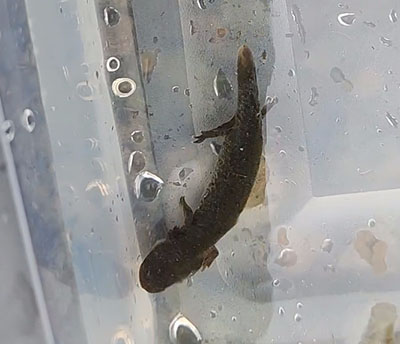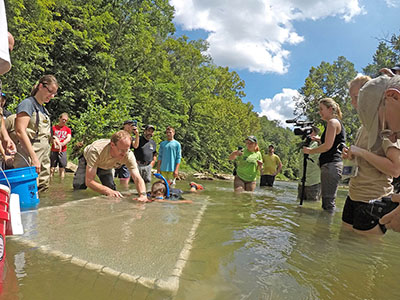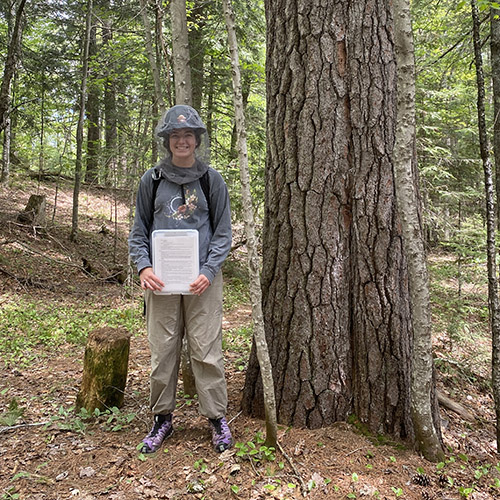Biologists with the Indiana Department of Natural Resources (DNR) and Purdue University recently documented a very young hellbender salamander, a gilled larva, in the Blue River while conducting routine surveys in south-central Indiana. This discovery is significant because over the past three to four decades, only adult hellbenders have been documented in the Blue River. The presence of a young salamander suggests that conservation efforts and rearing programs are accomplishing their goals for the recovery of this endangered species.
documented a very young hellbender salamander, a gilled larva, in the Blue River while conducting routine surveys in south-central Indiana. This discovery is significant because over the past three to four decades, only adult hellbenders have been documented in the Blue River. The presence of a young salamander suggests that conservation efforts and rearing programs are accomplishing their goals for the recovery of this endangered species.
The hellbender (Cryptobranchus alleganiensis) is a large, fully aquatic salamander. Hellbenders do not reach sexual maturity until they are 7-8 years old and require specific habitats to thrive and reproduce. Their decline statewide has been documented as far back as the early-to-mid 1900s as a result of habitat loss and poor water quality. Hellbenders play an important role in aquatic ecosystems and are indicators of clean water.
“Finding hellbender larvae is a huge benchmark of the program’s success,” said DNR’s Nate Engbrecht, the state herpetologist. “It tells us that there has been successful breeding, hatching, and recruitment in the wild. It’s a wonderful sign that captive-reared and released hellbenders are doing what we want them to do at this site.”
The hellbender found by Engbrecht and Purdue hellbender program coordinator Nick Burgmeier was a gilled larva measuring 6.5 centimeters in total length with a 5 centimeter snout-vent length. Based on its size, this animal is estimated to be eight months old.
While hellbender larvae may have been found by fisherman while seining over the years, none have been officially reported to the state herpetologist or to fisheries biologists of the Indiana DNR. The last documented juvenile was reported by William H. Kern Jr. in 1983.
In the event anglers accidentally hook a hellbender, they are reminded to cut the line, let the salamander go unharmed and report the sighting to a natural resource professional.
The importance of the larval sighting is that it shows that the Help the Hellbender partnership’s conservation efforts, breeding and rearing programs are trending in a positive direction.
efforts, breeding and rearing programs are trending in a positive direction.
“Our early research on the lack of reproduction and recruitment indicated it was most likely the result of low population numbers,” said Dr. Rod Williams, director of the Help the Hellbender lab at Purdue. “For the past 12 years, Purdue and zoo partners have worked tirelessly to rear and release animals back into the wild, increase population sizes, and ultimately the chance for natural breeding. This finding, the result of nearly two decades of collective effort, signifies a milestone for our conservation program. While we have much left to do, we have evidence our approach is working.”
The Indiana Hellbender Partnership is a collaboration between the Indiana DNR and Purdue University with funding support from the Indiana DNR Nongame Wildlife Fund, U.S. Fish & Wildlife Service, and partners in local governments, universities, non-governmental organizations, and zoos that are working to recover the state-endangered hellbender. Developed over 15 years, the Indiana Hellbender Partnership is the largest and most comprehensive group working to recover an imperiled amphibian in Indiana.
"The partnership has grown from just Purdue, the IDNR and a couple of zoos rearing hellbenders to a diverse group of Indiana and surrounding states' best conservation minds collectively providing input to advance hellbender conservation," Burgmeier said. "The Nature Conservancy, the Kentucky Department of Fish and Wildlife, the Indiana DNR and local Soil and Water Conservation Districts among others have really helped push the partnership towards its goal of restoring hellbender populations in the region."
For much of the last 17 years, Williams and his team have been researching eastern hellbenders, spearheading regional conservation efforts and advancing hellbender captive propagation, or the rearing of this ancient animal in captivity and their eventual return to the wild.
Since 2017, Purdue University’s Help the Hellbender Lab and its conservation partners have reared and released nearly 500 juvenile hellbenders into the Blue River.
Williams’ hellbender lab is actively collaborating with the Indiana Department of Natural Resources, Indiana Division of Fish and Wildlife, The Nature Conservancy, the Natural Resources Conservation Service, and multiple Indiana zoos, as well as several other partners across 13 states on a number of conservation projects and educational opportunities for teachers and children, farmers and more.

The “Farmers Helping Hellbenders” project, led by Williams and Burgmeier was selected in August 2022 to receive $2.7 million in funding through the RCCP Classic fund. The project aims to improve hellbender habitat in a four-county region in south central Indiana, the only remaining habitat for hellbenders in the state, by expanding the use of agricultural conservation practices that lead to decreased sedimentation in local rivers systems. Williams talks more about hellbenders and the project in this YouTube video.
The Williams lab and its partners will continue their hellbender conservation efforts through a new grant “Expanding Hellbender Recovery in Indiana” through a nearly $940,000 grant from the Indiana DNR. The project, which is slated to last from July 2023 through the summer of 2027, will result in the release of more than 500 animals back into the Blue River. The project will also expand releases into a new waterway as efforts continue to restore hellbenders throughout suitable habitat within the state.





